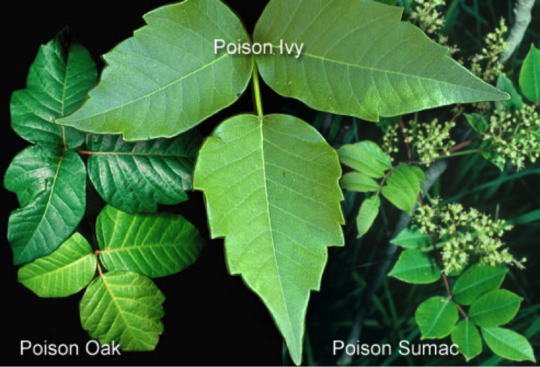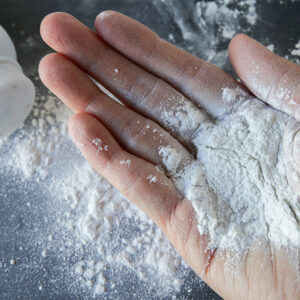
Easy Ways to Destroy This Yard Menace Without Harsh Chemicals
- Find out if this source of itchy and blistery pain is hiding in your yard today!
- Discover the one thing you should never do when disposing of this plant
- Call in the reinforcements! If you can find them. Learn more…
Dear Living Well Daily Reader,
“Leaves of three, let it be. Berries white, run in fright…”
If this saying rings a bell, then chances are you live somewhere with poison ivy.
And if you’ve ever experienced the nasty, itchy, blistery rash that comes from brushing up against one of these prolific vines and bushes, then you know they can cause serious pain
But they aren’t alone. Poison oak and poison sumac can also cause devastating pain and discomfort to your skin.
You see, all three of these plants contain a long-lasting oil called urushiol, which can cause a painful, itchy flare-up even after slight contact.
Unfortunately, you don’t have to be an avid hiker or camper to have a run-in with urushiol. Actually, you may not have to look any further than your own outdoor space to find these biting plants.
And while you definitely don’t want this ticking time bomb of discomfort planting roots in your yard, you probably don’t want to douse your lawn in harsh chemicals, either.
So what can you do?
Well, the good news is there’s a chemical-free solution to ridding your turf of these pesky plants. I will share this natural concoction in just a bit. First, let’s talk about gearing up for clearing them out of your yard.
![]() You’ll Need More Than a Pair of Gloves
You’ll Need More Than a Pair of Gloves
Pulling these plants might be the quickest way to clear them, since the results are immediate. Surprisingly, there are folks who are immune to the effects of urushiol. If you are lucky enough to know someone who has this immunity, ask them to help you remove the plants. If not, you need to make sure you have the proper gear.

Poison Ivy leaves may also have smooth edges. Be on the lookout for both.
Source: outdoororbivore.com
First things first, make sure you have a quality pair of gloves without any holes to cover your hands.
Next, you will want to make sure you have covered every part of your body that may come in contact with the plant. This might mean duct-taping your pants to your socks and your shirt sleeves to your gloves. Plus, you will need eye protection, a face mask, and something to cover your neck.
Once you’re fully suited, you can get to removing the plants.
For best results, after you’ve pulled the plant, dig in the soil (up to eight inches) to ensure there is no root left. When the plants and roots are removed, put some cardboard over the removal area to impede regrowth.
Place all plants in a heavy-duty trash bag and store in a safe place for garbage collection.
![]() Never burn these plants!
Never burn these plants!
Burning urushiol plants, even when they are dead, can produce smoke that is extremely irritating to the eyes, nasal passages, and lungs. In fact, it’s been thought that burning poison ivy could have been the inspiration for mustard gas.1
After you’re done pulling and bagging the plants, remove your clothes carefully and wash immediately. Urushiol can be active on surfaces for up to five years, so you may want to wash your clothes twice to be safe.2
![]() Spray Away!
Spray Away!
If pulling the plants doesn’t seem to do the trick or you just don’t want to risk contact, there are a couple other ways to tackle these backyard threats. One of these is with a homemade herbicide.
Here is what you will need:
- 1 pound of salt
- 1/2 gallon of water
- 2 cups of white vinegar
- 1/4 cup of biodegradable dish soap.
Combine all ingredients in a weed sprayer and stir until fully dissolved. Next, spray the offending vegetation until fully coated. This mixture will kill any plant it touches, so be sure you’re only dousing the plants you want destroyed.
Also, it’s best to apply the solution on sunny days so that rain doesn’t wash it away. It may take a few applications, but it will kill any unwanted plant guests.
And lastly, you can call in reinforcements of the animal kind…
Goats are completely immune to urushiol and make fast work of destroying these plants. Plus, it’s a treat for them!
If you don’t own a goat or know of one you can barrow, some areas have goat rental services. Check the web to see if there are is a rent-a-goat service near you!
Live well,

Natalie Moore
Managing editor, Living Well Daily
Sources
[2] POISONOUS PLANTS
[3] What is the best way to get rid of poison ivy?
Written By Natalie Moore
Natalie Moore is a dedicated health researcher with a passion for finding healthy, natural, and science-based solutions. After a decade of direct healthcare experience in western and natural medicine, she was involved in public health research before joining Living Well Daily.
View More Free Articles
The Secret Ingredient to a Longer, Happier Life
Let’s face it. We’re all in need of an attitude adjustment from time to time. After all, when you turn on the news these days, the world can seem pretty dark. That is unless you make it a practice to look for the silver linings. In fact, Harvard researchers say when you do, something quite...
Do You REALLY Need All Those Skincare Products?
I often get questions about skincare products—and here’s what I’ve learned. In today’s beauty-obsessed world, it’s easy to fall into the trap of spending hundreds every month believing you need countless products to fight aging and achieve healthy, glowing skin. However, many dermatologists argue that LESS is MORE when it comes to skincare. Simplifying your...
“Ebb and Flow” Technique TRANSFORMS Senior Brain Health
You know by now that exercise is good for you. It keeps your heart healthy, your muscles strong, and your waistline trim. But what if I told you that a trendy “ebb and flow” workout technique—often associated with young fitness enthusiasts—could actually be a game-changer for us “oldsters” when it comes to brain health? And...
Mailbag: Slash Your Risk of Bone Fractures as You Age
“My doctor recently told me that I have osteoporosis. What can I do to reduce my risk of fractures and maintain strong bones as I age?” – Margaret Hi Margaret, Sorry to hear about your diagnosis. I’m sure it was a shock. Osteoporosis is a serious condition that affects millions of people, and it’s not...
Household Favorite EXPOSED as Cancer Risk?
We all want to believe that the products we use daily are safe. After all, if they weren’t, they wouldn’t be on store shelves, right? Well, I hate to break it to you, but sometimes, the truth is far more alarming than we’d like to admit. The World Health Organization (WHO) has just dropped a...
Hidden Heatwave Threat REVEALED
Heat waves can have serious consequences. After all, staying cool isn’t just a comfort issue. When the mercury soars, it threatens your health—especially when you’re a senior. There are various reasons for this, including chronic medical conditions and bodies that just don’t regulate temperature as well as they once did. But there’s another heat-linked threat...
The Hidden Threat Behind Your Achy Joints
Picture this… You’re trying to enjoy a leisurely stroll in the park, but each step sends a jolt of pain through your knee. Or maybe you’re attempting to open a stubborn jar lid, only to have your fingers refuse to cooperate, leaving you feeling frustrated and helpless. Perhaps you’re simply trying to get out of...
Parkinson's Signs You Can't Afford to Miss
Imagine waking up one day to find your body betraying you. Your hands tremble as you try to button your shirt. Your feet shuffle when you want to walk with purpose. Once strong and clear, your voice now barely reaches above a whisper. This is the reality for those living with Parkinson’s. But what if...
Do Protein Needs Drop with Age? The SURPRISING Answer
I had a patient ask me the other day if they needed as much protein now as when they were younger. After all, we aren’t quite as active as seniors compared to when we were spring chickens. It’s a good question. And the answer might surprise you… Remember when you could devour a whole pizza...
Follow Your “Gut Feeling” to Reduce Diabetes Risk
It seems like every day we learn something new about the incredible influence our gut has on our overall health. From mood to immunity, and even to how well we sleep, the community of microbes in our digestive tract is pulling the strings behind the scenes. So, it should come as no surprise that researchers...









